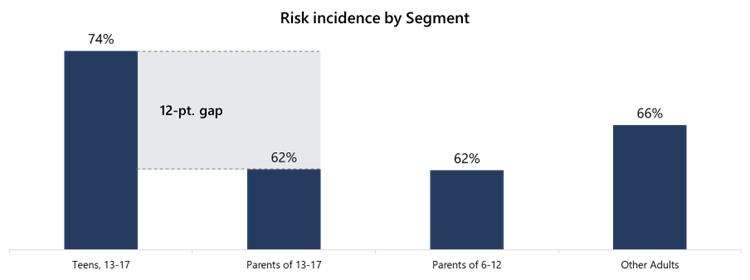
By Courtney Gregoire – Chief Digital Safety Officer
Today is international Safer Internet Day, a global event bringing people together to create a safer internet. For the past six years, Microsoft has taken this opportunity to advocate for digital civility – treating those we meet online with dignity and respect – and released research to help better understand peoples’ online experiences. This year, we’ve evolved our research and we’re pleased to release our new Global Online Safety Survey 2023: Parents’ and Kids’ Perceptions of Online Safety as part of our contribution to making the internet a safer place to work, play and engage with others.
Our 2023 survey found that 69% of people surveyed had experienced an online risk in the last year. The most common risks encountered globally were misinformation and disinformation, and personal risks (including cyberbullying, hate speech and threats of violence). Respondents in the UK (50%) and Germany (56%) were least likely to experience an online risk, while respondents in the Philippines (86%) and Chile (79%) were most likely to experience an online risk.
Parents underestimate online risks to teens in every category
The research found that teens experienced online risks at a higher rate than parents believed: 74% of teens reported experiencing an online risk, whereas 62% of parents believed their teen had encountered a risk online – a 12-point difference.
We also found that parents not only underestimated the risks – but did so in every category. The biggest gaps pertained to hate speech, closely followed by threats of violence, exposure to suicide and self-harm content, and cyberbullying and abuse. For example, 39% of teens reported experiencing hate speech online while only 29% of parents reported their teen having such an experience. Some 19% of teens experienced a threat of violence while only 11% of parents reported the same.
Teens also worry more about threats of violence in the future than do parents.
After experiencing an online risk 60% of teens talked to someone about it: 71% of those teens talked to their parents; 32% talked to friends; and 14% talked to another adult who wasn’t their parent.
Parents use safety tools because they believe they keep their kids safer online
Most parents report taking action to keep their kids safer online – including checking their children’s profiles and posts, receiving activity reports and regularly talking to their children about their online activities. This year’s research showed that parents generally viewed safety features as effective tools to help keep their children safe online, and 81% of parents report using at least one. Parents of younger children ages 6-12 were much more likely than parents of teens to use platform-based safety tools and used 4.4 tools compared to parents of teens (3.5). Tools that enabled parents to review friend/follow requests (71%) and limits to online spending (69%) were believed by parents to be most effective.
Microsoft’s commitment to digital safety
At Microsoft, we have a longstanding commitment and multifaceted approach to child online safety and this research shows us that we all – tech companies, governments, civil society and families – need to continue to work together for a better internet.
We remain committed to advancing digital safety across four pillars: platform architecture; content moderation; culture; collaboration. We know that safety by design is key to platform architecture, as well as building in safety features for families. And having clear safety policies coupled with consistent, proportionate action to enforce those policies is paramount to protecting users. Survey respondents overwhelmingly agree, with 85% expecting content moderation for illegal content (28%), and illegal and harmful content (57%).
Empowering users to create safe and inclusive online communities enables all to more fully participate in digital environments. That includes helping people understand the risks they may face online and ways in which people can protect themselves and their families.
Finally, multistakeholder collaboration remains critical to tackling the intersection of real-world and digital harms. That’s why we were proud to join France’s President Macron and the Childhood Online Protection Laboratory launched at the Paris Peace Forum in November 2022, and why we will continue to work with policymakers and others around the world to shape effective, proportional responses to help make the internet a safe space for everyone.
We understand that many parents are looking for educational resources and guidance to help them customize the online safety experiences for their families, and are pleased to provide the following:
- Resources | Microsoft Online Safety
- Global survey results and tips for teens and parents
- Xbox Family Hub
- Resource for families to setup a child account on Xbox and information for families for privacy and safety
- Microsoft Family Safety
- Empowers families to create healthy habits and protect them with digital and physical safety guidance and tools
- Xbox Family Settings App
- Manage children’s gaming console gaming activities
- Xbox Safety Guidance
- Xbox’s evolving approach to safety, the new Privacy Prodigy from Minecraft Education, and tips and tools that parents can use with their families to play on Xbox
We also know that gaming can be an invaluable tool for learning, so this Safer Internet Day, Minecraft: Education Edition is releasing an immersive game-based learning adventure, Privacy Prodigy, for students ages 7-18. Players will take on the challenge of protecting their data as they venture further from home. They will be faced with scenarios that help them learn about the personal information that can be shared and what should be kept private. Privacy Prodigy is a continuation of the CyberSafe series introduced last year with Home Sweet Hmm, and will be available for free for both Minecraft Education and in the Marketplace.


























